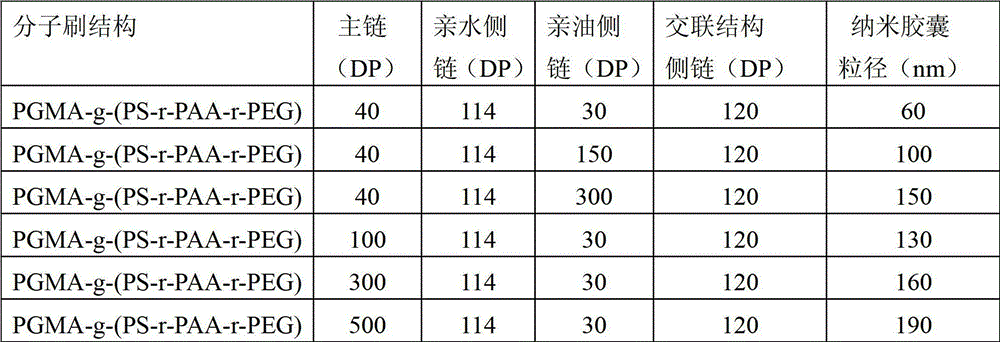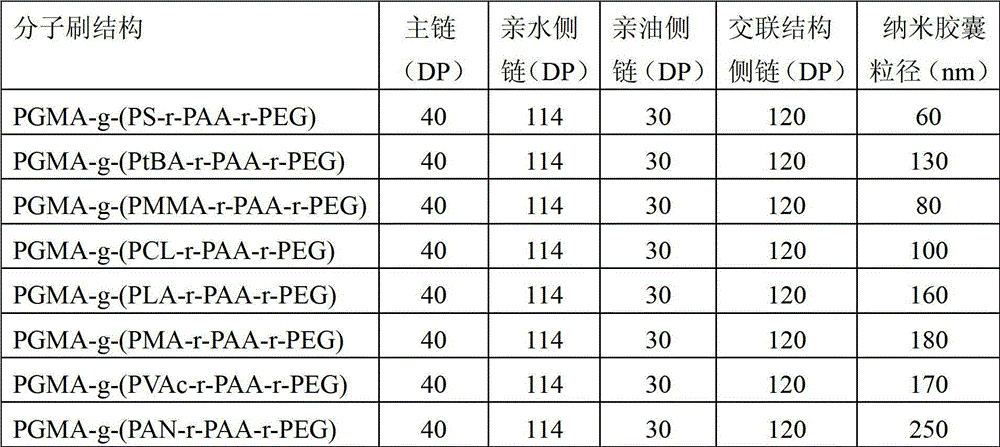Amphipathic ternary molecular brush polymer constructed multichannel nanocapsule
A ternary molecular brush and polymer technology, applied in microcapsule preparation, microsphere preparation and other directions, can solve the problems of difficult and harsh conditions of block copolymer, and achieve the effect of easy adjustment and control of size and simple operation.
- Summary
- Abstract
- Description
- Claims
- Application Information
AI Technical Summary
Problems solved by technology
Method used
Image
Examples
Embodiment 1
[0049] An amphiphilic ternary molecular brush polymer is prepared by the following steps:
[0050] (1) P(GMA-N 3 ) main chain synthesis
[0051] Take 1 part of ethyl 2-bromoisobutyrate initiator, 200 parts of glycidyl methacrylate (GMA), 100 parts of diphenyl ether, 1 part of CuBr and 1 part of N,N,N',N',N" -Pentamethyldiethylenetriamine (PMDETA), conduct ATRP reaction at 30°C for 1 hour under nitrogen protection, and obtain polyglycidyl methacrylate (PGMA) with a degree of polymerization (DP) of 40.
[0052] Take 100 parts of PGMA (DP=40), 100 parts of NaN 3 , 500 parts of dimethylformamide (DMF) and 1 part of AlCl 3 , reacted at 50°C for 24 hours to obtain P(GMA-N 3 ), as the main chain.
[0053] (2) Synthesis of three side chains
[0054] Synthesis of hydrophilic side chains: Take 100 parts of monomethoxypolyethylene glycol (Mn=5000), 20 parts of 2-propynylacetic acid, 20 parts of 4-dimethylaminopyridine (DMAP), 20 parts of 1-( 3-Dimethylaminopropyl)-3-ethylcarbodiim...
Embodiment 2
[0064] The preparation method and raw material composition are the same as in Example 1, and only the main chain of the amphiphilic ternary molecular brush polymer in Example 1 and the degree of polymerization of the three side chains are adjusted to obtain nanocapsules with different particle sizes . The degree of polymerization of the main chain and three side chains, and the particle size of the nanocapsules are shown in Table 1.
[0065] Polymers with main chain polymerization degrees of 100, 300, and 500 and polymers with lipophilic side chain polymerization degrees of 150 and 300 can be prepared according to the method of Example 1 by controlling the polymerization reaction time. The grafting ratios of PEG, PAA, and PS side chains of each amphiphilic polymer molecular brush were 20%, 10%, and 20%, respectively.
[0066] Table 1: The effect of the main chain and side chain polymerization degree of molecular brushes on the particle size of nanocapsules
[0067]
[006...
Embodiment 3
[0070] The preparation method and raw material composition are the same as in Example 1, only changing the composition of the lipophilic side chain of the amphiphilic ternary molecular brush polymer in Example 1, nanocapsules with different particle sizes can be prepared. The composition of the lipophilic side chain and the particle size of the nanocapsules are shown in Table 2.
[0071] The preparation method of PtBA, PMMA, PCL, PLA, PMA, PVAc, and PAN with a degree of polymerization of lipophilic side chains of 30 is similar to that of PS, and is prepared by commonly used ARTP.
[0072] The grafting ratios of PEG, PAA, and lipophilic side chains of each amphiphilic polymer molecular brush were 20%, 10%, and 20%, respectively.
[0073] Table 2: The influence of the lipophilic side chain composition of molecular brushes on the particle size of nanocapsules
[0074]
[0075] It can be seen from Table 2 that nanocapsules with different particle sizes can be prepared by chang...
PUM
| Property | Measurement | Unit |
|---|---|---|
| particle diameter | aaaaa | aaaaa |
| particle diameter | aaaaa | aaaaa |
| particle diameter | aaaaa | aaaaa |
Abstract
Description
Claims
Application Information
 Login to View More
Login to View More - R&D
- Intellectual Property
- Life Sciences
- Materials
- Tech Scout
- Unparalleled Data Quality
- Higher Quality Content
- 60% Fewer Hallucinations
Browse by: Latest US Patents, China's latest patents, Technical Efficacy Thesaurus, Application Domain, Technology Topic, Popular Technical Reports.
© 2025 PatSnap. All rights reserved.Legal|Privacy policy|Modern Slavery Act Transparency Statement|Sitemap|About US| Contact US: help@patsnap.com



